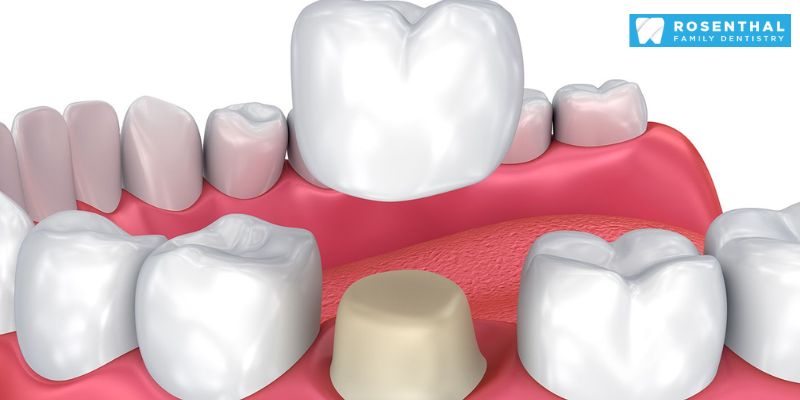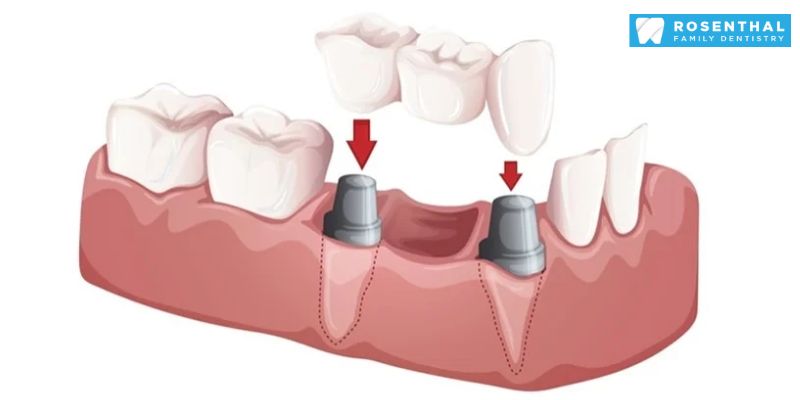A confident, bright smile can be a great asset, enhancing self-esteem and leaving a lasting impression. However, dental issues like decay, trauma, or missing teeth can hinder that confidence. Enter restorative dentistry, a field that aims to bring back the sparkle to your smile. In this comprehensive guide, we will delve into the world of dental crowns and bridges, exploring how these interventions can enhance your oral health and overall well-being.
Understanding the Basics
Let us start with the fundamentals. Dental crowns and bridges are two standard restorative solutions dentists employ to address various dental concerns.
Dental Crowns

Dental crowns, often called caps, are versatile restorative solutions designed to address various dental concerns. Crafted from materials like porcelain, ceramic, or metal alloys, crowns serve as protective covers for damaged or decayed teeth. This versatile intervention restores a tooth’s shape and enhances its strength and appearance. Dental crowns provide a durable and natural-looking solution, whether used for cosmetic purposes or to shield weakened teeth from further damage. Their custom fabrication ensures seamless integration into your smile, boosting aesthetics and functionality for a confident and lasting restoration.
Dental Bridges

Dental bridges are prosthetic devices serving as reliable solutions for missing teeth. Bridges are anchored to adjacent natural teeth or dental implants by combining one or more artificial teeth, known as pontics. This restorative intervention fills gaps left by missing teeth and prevents surrounding teeth from shifting, maintaining proper dental alignment.
The process involves preparing the adjacent teeth to support the bridge, creating a stable foundation. Beyond restoring functionality, dental bridges contribute to the aesthetic appeal of your smile. Crafted to match your natural teeth’ color, shape, and size, bridges provide seamless integration, offering a confident smile and improved oral health.
Common Reasons for Restorative Dentistry
Several dental issues may warrant the use of crowns and bridges:
- Tooth Decay: Dental crowns often treat extensive tooth decay that cannot be resolved with a simple filling. The crown encases the damaged tooth, providing both protection and aesthetic improvement.
- Chipped or Cracked Teeth: Accidents happen, and crowns can rescue when they involve the teeth. They offer a durable and natural-looking solution to restore the shape and integrity of a damaged tooth.
- Missing Teeth: Gaps left by missing teeth can affect your bite, speech, and oral health. Dental bridges provide a reliable solution to fill these gaps, restoring functionality and enhancing the cosmetic appeal of your smile.
The Restoration Process
Now that we understand the purpose of crowns and bridges, let us walk through the typical process of getting these restorative treatments.
- Consultation: It all begins with a visit to your dentist. During the initial consultation, your dentist will assess your oral health, discuss your concerns, and determine the most suitable treatment plan.
- Preparation: The affected tooth is prepared for dental crowns by removing a portion of its outer layer to create space for the crown. Impressions of the prepared tooth are then taken to ensure a custom-fit crown. In the case of dental bridges, the adjacent teeth (abutments) are prepared similarly to accommodate the bridge.
- Temporary Restorations: While the permanent crowns or bridges are being fabricated in a dental laboratory, temporary restorations are placed to protect the prepared teeth.
- Custom Fabrication: Skilled dental technicians use your impressions to craft custom crowns or bridges that match the color, shape, and size of your natural teeth, ensuring a seamless integration into your smile.
- Final Placement: Once the permanent restorations are ready, you return to the dentist for the final placement. The temporary crowns or bridges are removed, and the custom ones are securely affixed, making the necessary adjustments for comfort and alignment.
Benefits of Crowns and Bridges
Enhanced Aesthetics
Enhanced aesthetics through dental restorations like crowns and bridges redefine your smile. Designed to blend with natural teeth seamlessly, these interventions restore harmony and attractiveness to your oral appearance. The customized fabrication ensures a perfect color, shape, and size match. Experience a boost in confidence as your smile becomes a reflection of both beauty and optimal oral health.
Improved Functionality
Improved functionality is a crucial benefit of dental crowns and bridges. These restorative interventions enhance your ability to chew, speak, and maintain proper dental alignment. Addressing decay or missing teeth contributes to the oral cavity’s overall efficiency. Enjoy the freedom to eat, speak, and smile confidently, knowing that your teeth are aesthetically pleasing and fully functional.
Durability
Durability is a hallmark of dental crowns and bridges. These restorations are crafted from high-quality materials such as porcelain, ceramic, or sturdy metal alloys and offer long-lasting resilience. Withstanding the daily rigors of chewing and biting, crowns and bridges provide a durable solution, ensuring that your restored teeth maintain their strength and integrity for an extended period. Trust in the robust construction of these restorations for lasting oral health and peace of mind.
Prevention of Further Damage
Dental crowns excel at preventing further damage to weakened teeth. Encapsulating and fortifying decayed or damaged teeth, crowns act as protective shields, averting additional harm. This preventive measure ensures the longevity of the affected tooth, minimizing the risk of further decay or structural compromise. Choosing dental crowns is not just about restoration; it is a proactive step toward safeguarding your oral health and preserving the integrity of your natural teeth.
Boosted Confidence
Experience a profound boost in confidence with dental crowns and bridges. These restorative interventions enhance your smile aesthetically and empower you to speak, eat, and interact without reservation. Knowing that your teeth are beautifully restored and fully functional promotes a positive self-image. Reclaim your confidence and let your smile radiate, as dental crowns and bridges provide a transformative solution beyond aesthetics, influencing your overall well-being and self-assurance.
Conclusion
In restorative dentistry, dental crowns, and bridges are not just fixes but smile-transforming miracles. Whether tackling decay, damage, or gaps, these interventions go beyond aesthetics, infusing confidence and joy. So, consult your dentist, take that step, and let your grin tell the world your story of resilience and renewal.


